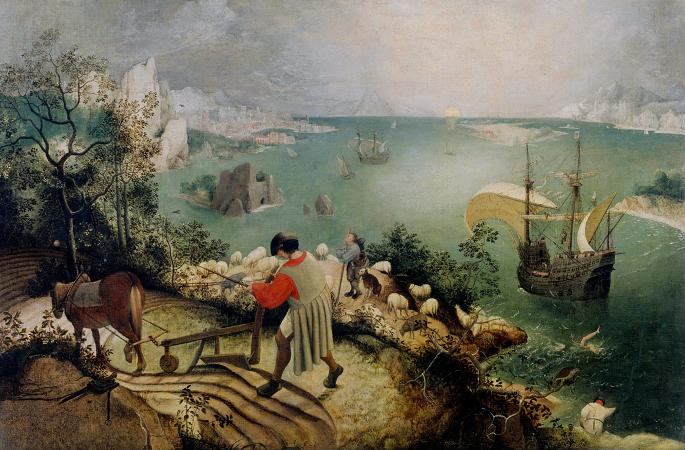Triumph of Death (c1562). Oil on panel. 117 x 162. The Triumph of Death is an oil panel painting by Pieter Bruegel the Elder painted c. 1562. It has been in the Museo del Prado in Madrid since 1827. The painting shows a panorama of an army of skeletons wreaking havoc across a blackened, desolate landscape. Fires burn in the distance, and the sea is littered with shipwrecks. A few leafless trees stud hills otherwise bare of vegetation; fish lie rotting on the shores of a corpse-choked pond. Art historian James Snyder emphasizes the scorched, barren earth, devoid of any life as far as the eye can see. In this setting, legions of skeletons advance on the living, who either flee in terror or try in vain to fight back. In the foreground, skeletons haul a wagon full of skulls; in the upper left corner, others ring the bell that signifies the death knell of the world. People are herded into a coffin-shaped trap decorated with crosses, while a skeleton on horseback kills people with a scythe. The painting depicts people of different social backgrounds-from peasants and soldiers to nobles as well as a king and a cardinal-being taken by death indiscriminately. A skeleton parodies human happiness by playing a hurdy-gurdy while the wheels of his cart crush a man like he's nothing. A woman has fallen in the path of the death cart; she has a slender thread which is about to be cut by the scissors in her other hand, Bruegel's interpretation of Atropos. Nearby another woman in the path of the cart, holds in her hand a spindle and distaff, classical symbols of the fragility of human life, another Bruegel interpretation of Clotho and Lachesis; a starving dog nibbles at the face of a dead child she holds. Just beside her, a cardinal is helped towards his fate by a skeleton who mockingly wears the red hat, while a dying king's barrels of gold and silver coins are looted by yet another skeleton; the foolish and miserly monarch's last thoughts still compel him to reach out for his useless and vain wealth, making him oblivious of repentance. In the centre, a sleeping pilgrim has his throat cut by a robber-skeleton for his money purse; above the murder, skeleton-fishermen catch people in a net. In the bottom right-hand corner, a dinner has been broken up and the diners are putting up a futile resistance. They have drawn their swords in order to fight the skeletons dressed in winding-sheets; no less hopelessly, the jester takes refuge beneath the dinner table. The backgammon board and the playing cards have been scattered, while a skeleton thinly disguised with a mask empties away the wine flasks. Of the menu of the interrupted meal, all that can be seen are a few pallid rolls of bread and an appetiser apparently consisting of a pared human skull. Above, a woman struggles in vain while being embraced by a skeleton in a hideous parody of after-dinner amorousness. To the right as the fighting breaks out, a skeleton in a hooded robe mockingly seems to bring another dish, also consisting of human bones, to the table, horrifying another woman with the realisation of mortality. In the bottom right-hand corner a troubadour who plays a lute while his lady sings; both are oblivious to the fact that behind both of them, a skeleton that plays along is grimly aware that the couple can not escape their inevitable doom. A cross sits in the centre of the painting. The painting shows aspects of everyday life in the mid-sixteenth century, when the risk of plague was very severe. Clothes are clearly depicted, as are pastimes such as playing cards and backgammon. It shows objects such as musical instruments, an early mechanical clock, scenes including a funeral service, and various methods of execution, including the breaking wheel, the gallows, burning at the stake, and the headsman about to behead a victim who has just taken wine and communion. In one scene a human is the prey of a skeleton-hunter and his dogs. In another scene, a man with a grinding stone around his neck is about to be thrown into the pond by the skeletons, an echoing of Matthew 18.6 and Luke 17.2. Bruegel combines two distinct visual traditions within the panel. These are his native tradition of Northern woodcuts of the Dance of Death and the Italian conception of the Triumph of Death, as in frescoes he would have seen in the Palazzo Sclafani in Palermo and in the Camposanto Monumentale at Pisa.
more...





